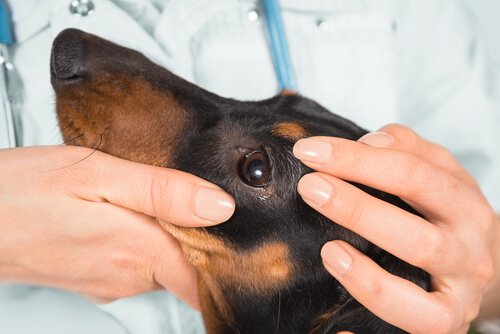Pink Eye in Dogs: Symptoms, Prevention, and Treatment

Pink eye, formally known as conjunctivitis, is as painful and uncomfortable for dogs as it is for people. That’s why it’s important to learn how to identify the symptoms and causes. A dog even puts his sight at risk upon contracting this infection.
Causes and symptoms of pink eye in dogs
Pink eye can appear to both cats and dogs. It’s an inflammation of the conjunctiva, the lining that covers up the whites of the eyes and eyelids. This condition is common with species that deal with dry eyes or autoimmune skin disorders.
Pink eye in dogs can start with a virus, bacteria, or a simple allergic reaction. Your pet will also experience specific symptoms that can help you identify it as pink eye. Here are some of them:
- Spasmic blinking.
- Overly watery or red eyes.
- Secretions from their eyes. They can be transparent, have mucus or pus.
- Swelling from fluid buildup in the conjunctiva.
- Formation of lymphoid follicles in the conjunctiva. A “follicle” is a small, semitransparent sack that appears in your eye tissue when it’s infected or injured. This occurs with a specific kind of pink eye called follicular conjunctivitis.
- Hypersensitivity to light. If you notice your dog staying away from the sunlight, he they might have some kind of eye infection.

In such cases, you have to take your dog immediately to the vet for proper diagnosis. One of the most common things they’ll do is fluorescein angiography, where they inject a fluorescent substance into its eye to see if there are any ulcers or other issues.
Types of pink eye in dogs
The symptoms and treatment will depend on what specific infection your dog has. Take a look at the following list of the most common types:
- Infectious conjunctivitis: This can be either viral or bacterial, and it’s contagious. You have to analyses the symptoms to figure out which kind it is. If your dog has a cold or a respiratory infection and there’s a very thin liquid coming out of the eyes, it’s probably viral pink eye. If it’s bacterial, the liquid will be much thicker.
- Autoimmune conjunctivitis. This can either be allergic or follicular. The first kind comes with springtime allergies and more pollen in the air, among other things.
- Neonatal conjunctivitis. This one is usually linked to viral or bacterial conjunctivitis.

There are other common kinds, like when it comes from tumors on the eyes, or other diseases like glaucoma or ulcerative keratitis.
A blockage in their tear ducts can also lead to pink eye. If this takes place you might have to send your dog to surgery.
Treatment and prevention
The key to preventing pink eye in dogs is good hygiene. Make sure the area around your dog’s eyes is always as clean as possible.

For some dogs, that also means keeping fur from growing over their eyes. Dogs’ fur can get dirty and pick up a lot of germs, and that can easily lead to an infection. When it comes to treatment, remember that the pink eye’s origin (a virus,bacteria, etc.) is key. No matter what, you have to clean out your dog’s eyes and always be wiping away the secretions.
You should only use eye-drops if your vet has prescribed them, because they sometimes have corticoids, which can actually make things worse depending on what kind of pink eye it is.
Pink eye, formally known as conjunctivitis, is as painful and uncomfortable for dogs as it is for people. That’s why it’s important to learn how to identify the symptoms and causes. A dog even puts his sight at risk upon contracting this infection.
Causes and symptoms of pink eye in dogs
Pink eye can appear to both cats and dogs. It’s an inflammation of the conjunctiva, the lining that covers up the whites of the eyes and eyelids. This condition is common with species that deal with dry eyes or autoimmune skin disorders.
Pink eye in dogs can start with a virus, bacteria, or a simple allergic reaction. Your pet will also experience specific symptoms that can help you identify it as pink eye. Here are some of them:
- Spasmic blinking.
- Overly watery or red eyes.
- Secretions from their eyes. They can be transparent, have mucus or pus.
- Swelling from fluid buildup in the conjunctiva.
- Formation of lymphoid follicles in the conjunctiva. A “follicle” is a small, semitransparent sack that appears in your eye tissue when it’s infected or injured. This occurs with a specific kind of pink eye called follicular conjunctivitis.
- Hypersensitivity to light. If you notice your dog staying away from the sunlight, he they might have some kind of eye infection.

In such cases, you have to take your dog immediately to the vet for proper diagnosis. One of the most common things they’ll do is fluorescein angiography, where they inject a fluorescent substance into its eye to see if there are any ulcers or other issues.
Types of pink eye in dogs
The symptoms and treatment will depend on what specific infection your dog has. Take a look at the following list of the most common types:
- Infectious conjunctivitis: This can be either viral or bacterial, and it’s contagious. You have to analyses the symptoms to figure out which kind it is. If your dog has a cold or a respiratory infection and there’s a very thin liquid coming out of the eyes, it’s probably viral pink eye. If it’s bacterial, the liquid will be much thicker.
- Autoimmune conjunctivitis. This can either be allergic or follicular. The first kind comes with springtime allergies and more pollen in the air, among other things.
- Neonatal conjunctivitis. This one is usually linked to viral or bacterial conjunctivitis.

There are other common kinds, like when it comes from tumors on the eyes, or other diseases like glaucoma or ulcerative keratitis.
A blockage in their tear ducts can also lead to pink eye. If this takes place you might have to send your dog to surgery.
Treatment and prevention
The key to preventing pink eye in dogs is good hygiene. Make sure the area around your dog’s eyes is always as clean as possible.

For some dogs, that also means keeping fur from growing over their eyes. Dogs’ fur can get dirty and pick up a lot of germs, and that can easily lead to an infection. When it comes to treatment, remember that the pink eye’s origin (a virus,bacteria, etc.) is key. No matter what, you have to clean out your dog’s eyes and always be wiping away the secretions.
You should only use eye-drops if your vet has prescribed them, because they sometimes have corticoids, which can actually make things worse depending on what kind of pink eye it is.
This text is provided for informational purposes only and does not replace consultation with a professional. If in doubt, consult your specialist.








